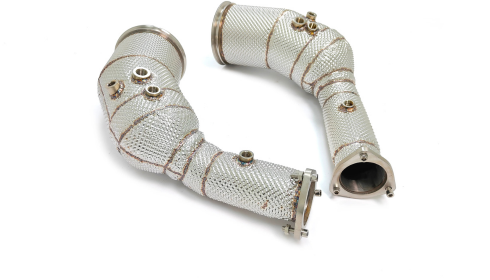The Audi RS6 C8 is a powerful and luxurious performance wagon that blends cutting-edge technology with aggressive design and outstanding speed. For automotive enthusiasts looking to unlock the true potential of this twin-turbo V8 machine, upgrading the downpipes is a popular modification. Whether you’re chasing more horsepower or simply want to hear the engine roar, audi rs6 c8 downpipes catless and catted offer distinct advantages. In this article, we’ll explore the key differences, benefits, and considerations of both catless and catted downpipes for the RS6 C8.
What Are Downpipes and Why Upgrade?
Downpipes are a section of the exhaust system that connect the turbochargers to the rest of the exhaust. In the case of the Audi RS6 C8, the downpipes are crucial in managing exhaust flow and emissions. Upgrading from the stock downpipes to performance versions can dramatically improve turbo response, reduce backpressure, and increase overall power output.
Many tuners and drivers replace the factory downpipes to either improve performance, enhance exhaust sound, or prepare the car for more advanced tuning stages. Choosing between catless and catted downpipes depends on personal goals, driving conditions, and local emission regulations.
Catless Downpipes: Maximum Performance
Catless downpipes do not include catalytic converters, allowing exhaust gases to flow more freely. This setup provides the highest performance gains due to reduced restriction. With catless downpipes, drivers can experience faster turbo spool, increased horsepower and torque, and a much louder exhaust note.
However, there are a few trade-offs:
- Check Engine Light (CEL): Most modern vehicles, including the Audi RS6 C8, are equipped with oxygen sensors that monitor emissions. Removing the catalytic converter may trigger a CEL unless the ECU is tuned accordingly.
- Emissions Compliance: Catless downpipes are generally not road-legal in many regions due to environmental regulations. They are better suited for off-road or track use.
- Stronger Exhaust Smell: Without a catalytic converter, unburnt fuel and other gases become more noticeable.
If your primary goal is to maximize performance and you’re building a track-focused car, catless downpipes are an excellent choice.
Catted Downpipes: Balanced Performance and Compliance
Catted downpipes, on the other hand, feature high-flow catalytic converters. These are designed to reduce emissions while still offering improved performance over the stock components. While they don’t provide quite as much horsepower gain as catless variants, they offer several advantages:
- Emissions Friendly: High-flow catted downpipes can help maintain compliance with emission standards in many areas, making them a safer choice for daily drivers.
- Reduced CEL Risk: While not entirely foolproof, catted downpipes are less likely to cause a check engine light compared to their catless counterparts.
- Toned Exhaust Sound: Catted downpipes offer a more refined exhaust tone—aggressive, but not overpowering.
For those who want a performance boost without completely removing emissions equipment, catted downpipes strike a great balance.
Installation and Tuning Considerations
Installing either type of downpipe on the Audi RS6 C8 typically requires professional installation due to the complexity of the engine bay and turbo placement. Additionally, a software tune is often recommended to fully realize performance gains and prevent potential issues like CELs or limp mode.
Tuning the ECU will:
- Optimize air-fuel ratios
- Eliminate CELs from O2 sensors
- Maximize horsepower and torque gains
- Improve drivability and throttle response
Choosing the Right Downpipe for You
When choosing between catless and catted downpipes, consider your driving habits, goals, and local regulations. If you’re looking to extract every last bit of performance and don’t mind the extra noise or emissions, catless might be for you. But if you want a daily-driven monster that remains legal and reliable, catted downpipes are a smarter upgrade.






